
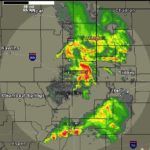 On the night of June 6th, 2012 a thunderstorm rolled over the Fort Collins area. I sat on my deck and enjoyed the brisk winds, as I watched the beautiful and violent lightning storm drill its white-hot tendrils into the foothills. We barely had any rain since Winter and the foothills never turned green this spring. I sat on the edge of my seat waiting for drops to fall, but by bedtime the storm had passed without shedding any water. Denver to the south, Cheyenne to the North and the Eastern plains were bombarded with rain and hail, and I was in disbelief that Fort Collins didn’t get a drop. I checked the radar map, and sure enough, the storm split like parted seas around the Fort Collins area, forming a dry void.
On the night of June 6th, 2012 a thunderstorm rolled over the Fort Collins area. I sat on my deck and enjoyed the brisk winds, as I watched the beautiful and violent lightning storm drill its white-hot tendrils into the foothills. We barely had any rain since Winter and the foothills never turned green this spring. I sat on the edge of my seat waiting for drops to fall, but by bedtime the storm had passed without shedding any water. Denver to the south, Cheyenne to the North and the Eastern plains were bombarded with rain and hail, and I was in disbelief that Fort Collins didn’t get a drop. I checked the radar map, and sure enough, the storm split like parted seas around the Fort Collins area, forming a dry void.
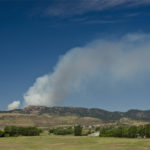 Saturday, June 9th. Three days later I woke up and headed straight into my backyard to tend my garden. I inspected my spinach for a short while, and when I looked back up there was a white plume of smoke rising straight up from the foothills. In my mind there was no mistaking what it was, and after the recent Hewlett Gulch fire all I could think was, “Oh crap, another wildfire!”
Saturday, June 9th. Three days later I woke up and headed straight into my backyard to tend my garden. I inspected my spinach for a short while, and when I looked back up there was a white plume of smoke rising straight up from the foothills. In my mind there was no mistaking what it was, and after the recent Hewlett Gulch fire all I could think was, “Oh crap, another wildfire!”
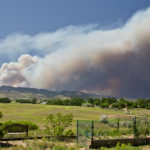 Lightning from the recent storm had seeded the forest floor with embers that smoldered for 3 days before strong winds gave them life. By mid afternoon this unnamed fire had spread from 0-14,000 acres like a hoard of locusts. It produced an opaque wall of smoke so immense that it obscured the entire northerly sky.
Lightning from the recent storm had seeded the forest floor with embers that smoldered for 3 days before strong winds gave them life. By mid afternoon this unnamed fire had spread from 0-14,000 acres like a hoard of locusts. It produced an opaque wall of smoke so immense that it obscured the entire northerly sky.
Sunday, June 10th. Armageddon. The wall of smoke that I thought couldn’t get any bigger, doubled in size. It now had a sinister depth and darkness to it that looked as if a massive cumulonimbus cloud had settled upon the Earth. The “High Park Fire” had grown to over 20,000 acres in less than 2 days. I thought that was big.
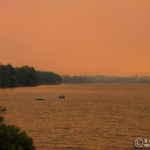 I have a compulsion to record all that I see in nature. This fire was an unfathomable event to which I needed to get closer so I could see what its heart looked like. It was like Godzilla had risen from the mountains and was headed for my city. Authorities closed off all routes to the fire so I drove through north Fort Collins instead. The city streets were eerily thick with smoke, which turned the evening sky orange as the sun filtered through.
I have a compulsion to record all that I see in nature. This fire was an unfathomable event to which I needed to get closer so I could see what its heart looked like. It was like Godzilla had risen from the mountains and was headed for my city. Authorities closed off all routes to the fire so I drove through north Fort Collins instead. The city streets were eerily thick with smoke, which turned the evening sky orange as the sun filtered through.
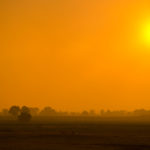 At dusk I drove up to the cliffs above the Horsetooth Reservoir, directly into the path of smoke. The fire was yet in the distance across several valleys. During strong wind gusts you could barely discern flames licking up and spreading their reach. I felt optimistic that we’d get it under control though. For the fire to reach enclaves of homes, and to flirt with the outskirts of Fort Collins, it would have to march across valleys and over the top of several ridges.
At dusk I drove up to the cliffs above the Horsetooth Reservoir, directly into the path of smoke. The fire was yet in the distance across several valleys. During strong wind gusts you could barely discern flames licking up and spreading their reach. I felt optimistic that we’d get it under control though. For the fire to reach enclaves of homes, and to flirt with the outskirts of Fort Collins, it would have to march across valleys and over the top of several ridges.
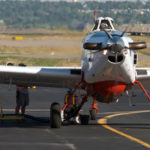 Monday, June 11th. While some slept and others fled, the dragon spread its wings. The flames had indeed traversed the foothills in all directions and were now upon the shores of the Horsetooth Reservoir. By late afternoon the flames had spread north and incinerated the facing wall of the foothills, which look directly into Fort Collins. At this point it appeared as if all of the foothills were on fire. 40,000 acres were bruning. My optimism now vanished as I couldn’t fathom how we could tame such thermal inertia.
Monday, June 11th. While some slept and others fled, the dragon spread its wings. The flames had indeed traversed the foothills in all directions and were now upon the shores of the Horsetooth Reservoir. By late afternoon the flames had spread north and incinerated the facing wall of the foothills, which look directly into Fort Collins. At this point it appeared as if all of the foothills were on fire. 40,000 acres were bruning. My optimism now vanished as I couldn’t fathom how we could tame such thermal inertia.
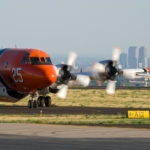
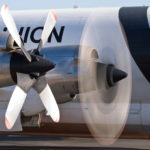
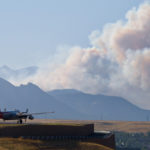
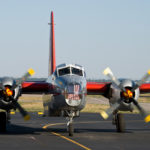 One must fight dragons with dragons. An armada of helicopters and water-bombers snarled in overhead to do battle. Giant helicopters that I read about as a kid flew directly over my house between the fire and their refueling point at the Ft. Collins-Loveland Airport. Prop-plane water bombers made from re-purposed, post WWII-era submarine hunters dropped flame retardant on the fire. After each drop they cruised 50 miles back to the Rocky Mountain Metro Airport in Broomfield to re-tank. I cheered as the Air Cavalry charged straight into the dragon’s breath. I photographed the water bombers below at the Broomfield, Rocky Mountain Metro Airport in 2010 fighting the Fourmile Fire.
One must fight dragons with dragons. An armada of helicopters and water-bombers snarled in overhead to do battle. Giant helicopters that I read about as a kid flew directly over my house between the fire and their refueling point at the Ft. Collins-Loveland Airport. Prop-plane water bombers made from re-purposed, post WWII-era submarine hunters dropped flame retardant on the fire. After each drop they cruised 50 miles back to the Rocky Mountain Metro Airport in Broomfield to re-tank. I cheered as the Air Cavalry charged straight into the dragon’s breath. I photographed the water bombers below at the Broomfield, Rocky Mountain Metro Airport in 2010 fighting the Fourmile Fire.
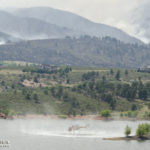
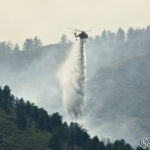 I went back up to the cliffs above the Horsetooth Reservoir to watch the choppers in action. Across the reservoir they were concentrating on a residential area where flames were invading. Among several helicopters on duty, the S-64 Air Cranes were most impressive. The Air Crane is based on a Vietnam-era heavy transport chopper that could lift and carry a cargo truck or artillery piece across a battlefield. In this role, the Air Crane was equipped with a tank that could hold 2,850 gallons of flame retardant or water…that’s 12 tons!
I went back up to the cliffs above the Horsetooth Reservoir to watch the choppers in action. Across the reservoir they were concentrating on a residential area where flames were invading. Among several helicopters on duty, the S-64 Air Cranes were most impressive. The Air Crane is based on a Vietnam-era heavy transport chopper that could lift and carry a cargo truck or artillery piece across a battlefield. In this role, the Air Crane was equipped with a tank that could hold 2,850 gallons of flame retardant or water…that’s 12 tons!
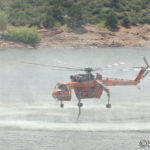
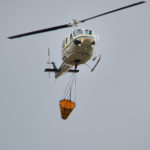 While surrounded by rising smoke, these brilliant pilots performed aerial surgery, precisely dropping lines of water around flame-imperiled houses. After each drop, the chopper hovered above the reservoir as its snorkel sucked up another load of lake water. It was amazing to see flames, just meters from houses, being held back by a square patch of soaked earth. Meanwhile, water-bombers barreled in and dropped walls of red flame-retardant, just ahead of the advancing fire. Weeks after the fire ended you could still see red stripes staining the foothills that had clearly stopped the flames.
While surrounded by rising smoke, these brilliant pilots performed aerial surgery, precisely dropping lines of water around flame-imperiled houses. After each drop, the chopper hovered above the reservoir as its snorkel sucked up another load of lake water. It was amazing to see flames, just meters from houses, being held back by a square patch of soaked earth. Meanwhile, water-bombers barreled in and dropped walls of red flame-retardant, just ahead of the advancing fire. Weeks after the fire ended you could still see red stripes staining the foothills that had clearly stopped the flames.
Helicopters saved many homes, but out here on the perimeter it was just a brush fire. Deeper within the High Park Fire it was a broiling hell that was devouring the forest and homes.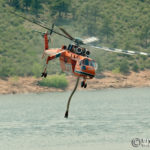
Saturday, June 16th. 55,000 acres burned, 85 square miles. Though ground crews and choppers had won battles over the past few days, the fire still spread unabated on many fronts.
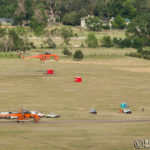 On an existing air strip in a grassy field, a bustling heliport was set up in north Fort Collins. It placed the helicopters a short, 3-minute flight from the fire’s edge. Dozens of helicopters- Air Cranes, Black Hawks, Hueys and more- thundered in and out as they fought the fire from dusk til’ dawn. Access to roads leading even remotely close to the heliport were blocked. Authorities had also closed access to the Horsetooth Reservoir, which meant I had no vantage points.
On an existing air strip in a grassy field, a bustling heliport was set up in north Fort Collins. It placed the helicopters a short, 3-minute flight from the fire’s edge. Dozens of helicopters- Air Cranes, Black Hawks, Hueys and more- thundered in and out as they fought the fire from dusk til’ dawn. Access to roads leading even remotely close to the heliport were blocked. Authorities had also closed access to the Horsetooth Reservoir, which meant I had no vantage points.
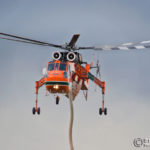 The heliport butted up against the facing wall of foothills, and Choppers flew right up over the spine of the foothills en route to the fire. If I happened to be up on that spine, it would put me within a stone’s throw of the helicopters as they flew by. I found a trail that lead right up to that spot.
The heliport butted up against the facing wall of foothills, and Choppers flew right up over the spine of the foothills en route to the fire. If I happened to be up on that spine, it would put me within a stone’s throw of the helicopters as they flew by. I found a trail that lead right up to that spot.
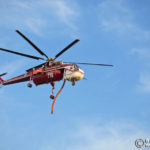 I climbed up to the ridge and what I saw was haunting. To the west; a decimated expanse of burned forest, burned houses, saved houses and smoke reaching miles into the sky. To the east: my city filled with apprehension as thick as smoke, and rotor blades revving into action. I had a clear view directly down into the heliport. At about 5:00 pm, presumably after down-time for maintenance, the Air Cranes began to fire up. They became aloft, and each maneuvered into a hover above giant, open basins filled with flame retardant. They dipped their snorkels into the basins and filled their tanks.
I climbed up to the ridge and what I saw was haunting. To the west; a decimated expanse of burned forest, burned houses, saved houses and smoke reaching miles into the sky. To the east: my city filled with apprehension as thick as smoke, and rotor blades revving into action. I had a clear view directly down into the heliport. At about 5:00 pm, presumably after down-time for maintenance, the Air Cranes began to fire up. They became aloft, and each maneuvered into a hover above giant, open basins filled with flame retardant. They dipped their snorkels into the basins and filled their tanks.
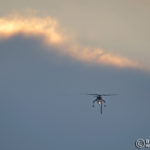 Now I was in for some real excitement. After tanking, the first Air Crane built its speed, banked and headed straight for me. It was no stretch to liken this machine to a friendly dragon, with its skeletal structure, fire-orange paint, and snorkel hanging down like a tail. It thundered past only 200 ft from me and made my chest cavity shake. By now the western edge of the fire was under control and the chopper disappeared into the smoke as it headed towards the interior. One by one, 5 Air Cranes went on the attack and returned to re-tank after each retardant drop. I can only assume they were either saving more homes or laying down lines of retardant to help contain the fire. For almost 4 hours, the choppers held an intense cadence of tanking and dropping until darkness forced them to land.
Now I was in for some real excitement. After tanking, the first Air Crane built its speed, banked and headed straight for me. It was no stretch to liken this machine to a friendly dragon, with its skeletal structure, fire-orange paint, and snorkel hanging down like a tail. It thundered past only 200 ft from me and made my chest cavity shake. By now the western edge of the fire was under control and the chopper disappeared into the smoke as it headed towards the interior. One by one, 5 Air Cranes went on the attack and returned to re-tank after each retardant drop. I can only assume they were either saving more homes or laying down lines of retardant to help contain the fire. For almost 4 hours, the choppers held an intense cadence of tanking and dropping until darkness forced them to land.
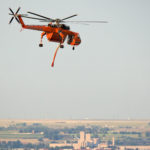 Afterwards I stayed up well into the morning sorting out my best photos. In between sorting and editing I searched the internet for pieces of the fire that I wasn’t able to witness; the fire fighters on the ground, lost homes, survivors and destroyed forest. I ended up on CNN’s website. A few of my photos of the High Park Fire made onto Colorado news (after advice to submit them from a friend), so decided to send my photos and a report to CNN, expecting nothing. The next morning a producer called me and asked if they could feature my photos on the front page of CNN.com. You can see my report on CNN here, although it’s only a fraction of what’s in this blog.
Afterwards I stayed up well into the morning sorting out my best photos. In between sorting and editing I searched the internet for pieces of the fire that I wasn’t able to witness; the fire fighters on the ground, lost homes, survivors and destroyed forest. I ended up on CNN’s website. A few of my photos of the High Park Fire made onto Colorado news (after advice to submit them from a friend), so decided to send my photos and a report to CNN, expecting nothing. The next morning a producer called me and asked if they could feature my photos on the front page of CNN.com. You can see my report on CNN here, although it’s only a fraction of what’s in this blog.
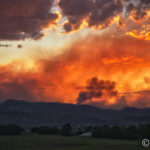 Sunday, June 17th. 57,000 acres. I was fascinated by these big choppers and what I’d seen their pilots accomplish, and wanted to video the Air Cranes. But when I returned to the trail leading to the ridge, it was closed. It might have been in response to my CNN photos, and this was the last vantage point authorities hadn’t thought to restrict. It was clear they didn’t want anybody to observe anything that was happening with the High Park Fire. Routes leading to the fire should certainly have been closed to the public, but safe areas far from the flames in which fire personal were not operating, such as this trail and the Horsetooth Reservoir, were also closed.
Sunday, June 17th. 57,000 acres. I was fascinated by these big choppers and what I’d seen their pilots accomplish, and wanted to video the Air Cranes. But when I returned to the trail leading to the ridge, it was closed. It might have been in response to my CNN photos, and this was the last vantage point authorities hadn’t thought to restrict. It was clear they didn’t want anybody to observe anything that was happening with the High Park Fire. Routes leading to the fire should certainly have been closed to the public, but safe areas far from the flames in which fire personal were not operating, such as this trail and the Horsetooth Reservoir, were also closed.
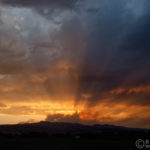 At this point the High Park Fire was still spreading fast, and far from containment. It continued to grow by thousands of acres per day. New evacuation orders emerged as the flames made unexpected advances. Strong winds let it jump the Poudre River and HWY 14. With the fire now spread over such a vast distance, the once looming wall of smoke dispersed into thick haze that obscured the foothills. The city of Fort Collins sullenly went on with its life as ash fell from above. At night, the flames reflected off the hanging smoke and created a bizarre orange glow in the sky.
At this point the High Park Fire was still spreading fast, and far from containment. It continued to grow by thousands of acres per day. New evacuation orders emerged as the flames made unexpected advances. Strong winds let it jump the Poudre River and HWY 14. With the fire now spread over such a vast distance, the once looming wall of smoke dispersed into thick haze that obscured the foothills. The city of Fort Collins sullenly went on with its life as ash fell from above. At night, the flames reflected off the hanging smoke and created a bizarre orange glow in the sky.
To make matters worse, environmental conditions only encouraged the flames. Dry evening thunderstorms brought strong winds and lightning, but no rain. By day, low humidity and record high temperatures were reached, along with almost constant wind. On a few occasions, spot containment had been achieved, and then lost. These conditions ignited wildfires along the front range and throughout Colorado, including the Flagstaff Fire in Boulder, and Waldo Canyon Fire in Colorado Springs. Colorado dominated the national news as the entire state seemed to be up in flames.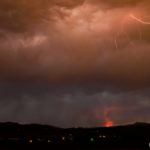
The High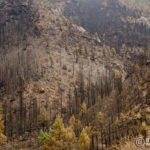 Park Fire burned for 3 weeks. It grew to 87,000 acres before it was finally brought to 100% containment on June 30th, 2012. It burned 136 square miles of forest, and destroyed 259 homes. In a twisted stroke of irony, the first week of July brought 3 days of intense monsoons. They doused the fire, but with exposed, scorched earth, caused mudslides, severe erosion and flooding. The Poudre River ran black with ash and its fish life killed.
Park Fire burned for 3 weeks. It grew to 87,000 acres before it was finally brought to 100% containment on June 30th, 2012. It burned 136 square miles of forest, and destroyed 259 homes. In a twisted stroke of irony, the first week of July brought 3 days of intense monsoons. They doused the fire, but with exposed, scorched earth, caused mudslides, severe erosion and flooding. The Poudre River ran black with ash and its fish life killed.
So was this massive fire a tragedy? For the human element that lost 259 homes, there’s no question. But ecologically, the answer is 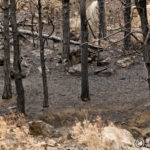 ambiguous. Small, 5-30 year periodic fires are not only good for the Ponderosa Pine forest, but necessary for a hea
ambiguous. Small, 5-30 year periodic fires are not only good for the Ponderosa Pine forest, but necessary for a hea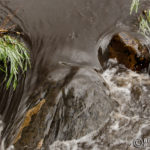 lthy forest. Trees thrive after small fires that don’t burn their crowns. But when homes are built within the forests of the foothills, fires must be suppressed. With no fires to clean the forest out, it becomes dense and overgrown, which decreases the health of individual tress. Densely spaced, unhealthy trees are more susceptible to infestation by the Pine Bark Beetle, which has become a plague. Fire suppression also causes accumulation of combustible debris on the forest floor. The High Park Fire however, was not a small, beneficial fire that merely cleaned out the forest. It destroyed all the trees in its path. Obviously, the land is not completely “dead”. Vegetation will return immediately, animals will return eventually, and it will be a forest of trees again in decades. So the question is, with such altered ecology, and vast swaths of beetle kill, was the forest far gone enough that burning it to the ground and starting over will end up being worth the short-term destruction and environmental degradation?
lthy forest. Trees thrive after small fires that don’t burn their crowns. But when homes are built within the forests of the foothills, fires must be suppressed. With no fires to clean the forest out, it becomes dense and overgrown, which decreases the health of individual tress. Densely spaced, unhealthy trees are more susceptible to infestation by the Pine Bark Beetle, which has become a plague. Fire suppression also causes accumulation of combustible debris on the forest floor. The High Park Fire however, was not a small, beneficial fire that merely cleaned out the forest. It destroyed all the trees in its path. Obviously, the land is not completely “dead”. Vegetation will return immediately, animals will return eventually, and it will be a forest of trees again in decades. So the question is, with such altered ecology, and vast swaths of beetle kill, was the forest far gone enough that burning it to the ground and starting over will end up being worth the short-term destruction and environmental degradation?

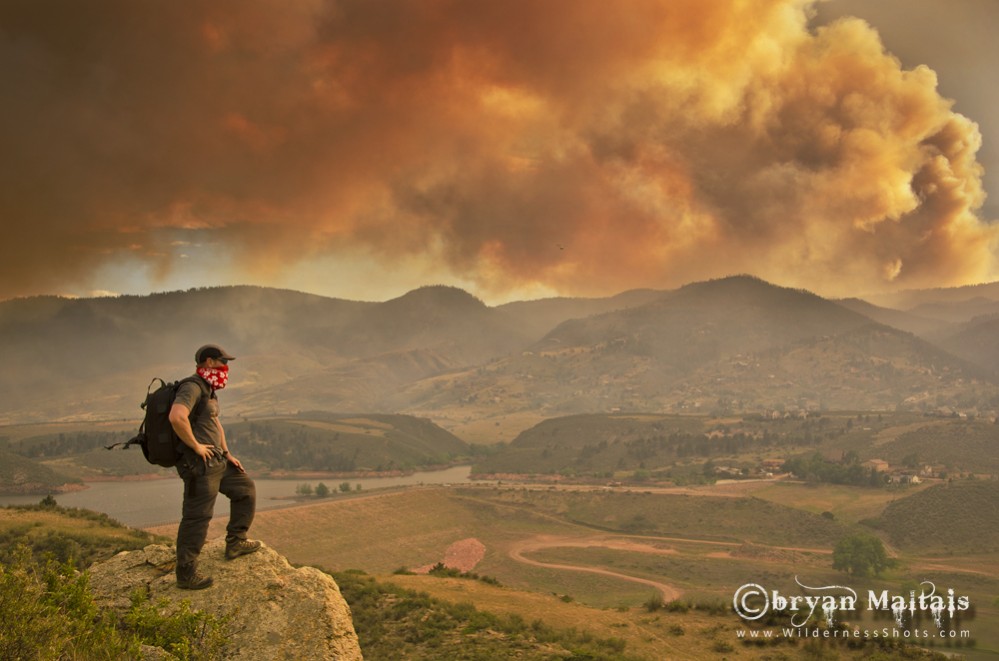
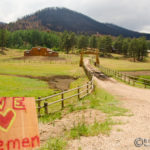
You’re the one with the brains here. I’m watching for your posts.